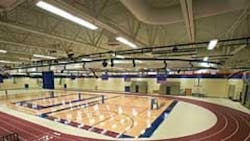Some recent stories have surfaced that convey that some green buildings are not achieving anticipated energy savings. Although possible, it is not the case for most sustainably designed construction projects for education institutions. In fact, many sustainable school buildings are experiencing significant energy savings—and will continue to for the life of the structure. An added bonus is that the initial price tag on these schools may be less than that of conventionally constructed schools.
But, in order to generate these savings, it is important to look at all of the options from the onset of a project, make wise and principled decisions throughout the project, and use a variety of evaluation methods to ensure that the building functions as designed.
Before construction
Energy modeling uses computer simulations to estimate the operation of a building over the course of a year to understand how energy is used in a building, and how it can be saved. Modeling can be used to guide design decisions in the planning and design phases of a project. In order to take advantage of the process of energy modeling, it is important to use these software tools early in the design process.
The project team must consider many variables: building orientation, form, windows, insulation, roof and wall types, and lighting and HVAC (heating, ventilation and air conditioning) systems. These are merely a fraction of the factors that will be entered into the program to project the future energy performance of a building.
Over recent decades, the building options available and the capability of the models have improved, and more tools and data are used to predict, evaluate and monitor energy performance. The U.S. Green Building Council (USGBC) increased the use of modeling, as it is required for LEED certification. Now, more education institutions are aware of the benefits of modeling and are expanding the use to evaluate items such as energy and water consumption, occupant comfort and indoor air quality.
The most important use of energy modeling is to inform design. Another use of modeling is to estimate future energy costs based on estimated energy use along with information on anticipated utility rates. The energy model also is useful to compare the actual performance of the school with the performance projected when the building was designed. Is the school performing as expected? If not, why not? Things as simple as failing to control lights or outside-air supply during periods when spaces are not occupied can have a large impact on an energy bill.
Another important activity in the design process is to maximize value trading. That is the process of making design changes and adding features with more value, and "paying" for those by eliminating design elements and features of less value. Value trading improves the overall design and performance of a project while staying within budget. It applies to all aspects of a project, not just energy-related components.
During construction
In recent years, the construction industry has recognized the value of using integrated product delivery (IPD). Rather than using separate design and construction entities, IPD brings the planning, design and construction experts together as an integrated team, typically under one contract. IPD helps ensure coordination of planning, design and construction to provide a project that operates more efficiently and effectively.
This integrated approach emphasizes brainstorming, collaboration, enhanced communication, planning and community consensus building. It engages the entire project team from the beginning and encourages the discovery of value-driven alternatives and fresh ideas until the project is completed.
An integrated process, such as total project management, is another consideration. This offers in a single firm the range of professional services required for a design and construction project.
After construction
Commissioning is another valuable tool that ensures a building design and operation meet the owner’s intent. It begins at the earliest phases of design, but its results become more apparent after construction is completed. Although some perceive commissioning as an unnecessary additional cost, it provides great value to a building owner. Commissioning makes certain that a design incorporates all of the goals and decisions that are established in the planning stages, that the construction means and methods meet the design specifications, and that the operational costs are meeting the targets set early in the design process. This service often is performed by a third-party commissioning agent.
Through commissioning and ongoing communication, project teams can work consistently to improve the performance of a facility. Large school projects are like custom sports cars—designed and constructed for maximum efficiency and performance. This requires a quality-control process so that administrators can be certain that the facility operates as planned and that facility managers are trained properly.
It is not unusual, for the first year or two of operation, to see additional utility savings, as ways are found to increase building comfort, reduce energy consumption, and fine-tune the operation and systems in the facility.
- Read the "The Process Delivers" sidebar to learn how Northland Pines High School in Eagle River, Wis., is saving energy.
Hoffman is owner and president of Hoffman LLC, an Appleton, Wis.-based firm that provides total project management services.
